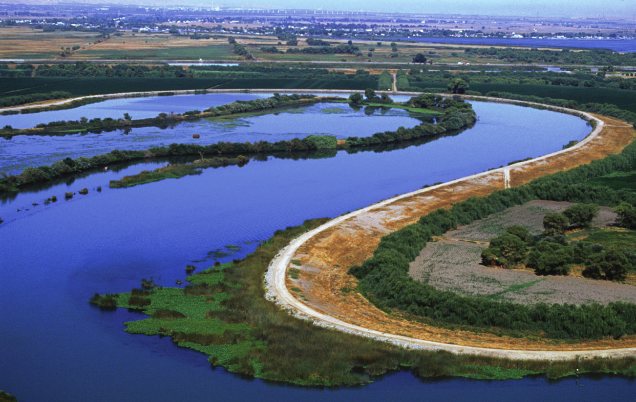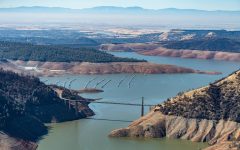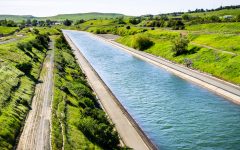
California Bay Delta water (Photo: USGS.gov)
Latest Attack on Proposed Sites Reservoir – Not Enough Water
Much of environmentalism today has morphed into a nihilistic, anti-human, extremist movement
By Edward Ring, September 4, 2022 2:30 am
When it comes to attacking anything that will make so much as a scratch in the earth, California’s environmentalists never run out of arguments, and their litigators never run out of money.
So it goes with the proposed Sites Reservoir, which is enduring a withering new bombardment from environmentalists in the wake of Governor Newsom’s recently announced Water Supply Strategy in which the governor endorsed the Sites Project and even had the temerity to suggest environmentalist obstruction is stopping as many good projects as bad ones.
As reported in the San Francisco Chronicle earlier this week, and dutifully highlighted in Maven’s Notebook, “California’s largest reservoir in nearly 50 years may be derailed by water shortages.” Apparently there isn’t enough water flowing down the Sacramento River to fill the 1.5 million acre foot reservoir. But that entirely depends on who you ask.
Shown below, courtesy of the US Dept. of Geological Survey, is flow data for the Sacramento River, upstream at Colusa, which is near to where the planned diversions into the Sites Reservoir will be made. The data is expressed in “CFS,” which stands for cubic feet per second.
What is immediately evident from this chart is how it vividly depicts the volume of surplus water that hit Northern California even during what has been described as the driest winter in decades. If during the on-and-off wet months from October 1 to April 30 just 20 percent of the Sacramento River’s flow had been diverted into the Sites Reservoir, nearly 550,000 acre feet could have been stored, more than a third of its capacity. And since the pumps in one of the original designs for the Sites Reservoir had a capacity of 5,900 CFS, which is equivalent to 11,700 acre feet per day, during the peak runoff events from October through December, at least another 100,000 acre feet might have been stored.
Put another way, if one-fifth of the Sacramento River’s flow upstream at Colusa had been diverted, and only during the seven mostly dry months from October 2021 through April 2022, the massive 1.5 million acre foot Sites Reservoir could have been filled nearly half way to capacity. In just one season, during a drought.
And why not? Drawing 1.0 million acre feet or more from the Sacramento River to fill the Sites Reservoir during wet years, and over a half-million acre feet even in dry years, would not significantly reduce the flow of fresh water into the Sacramento-San Joaquin Delta. The Sacramento River at Colusa is upstream from the Feather River, which adds its powerful flow 40 miles further south, as well as the American River, which joins the Sacramento River another 20 miles south. Other major tributaries that join the Sacramento River south of Colusa include the Butte River and the Yuba River. In addition, flowing into the Delta from the South is the San Joaquin River with its many tributaries.
An authoritative 2017 study by the Public Policy Research Institute describes so-called “uncaptured water,” which is the surplus runoff, often causing flooding, that occurs every time an atmospheric river hits the state. Quoting from the study, “benefits provided by uncaptured water are above and beyond those required by environmental regulations for system and ecosystem water.” The study goes on to claim that uncaptured water flows through California’s Sacramento/San Joaquin Delta “averaged 11.3 million acre-feet [per year] over the 1980–2016 period.”
When the average “uncaptured” water flowing through the Delta, “above and beyond those required by regulations for system and ecosystem water,” is 11.3 million acre-feet per year, suggesting there won’t be enough water to fill the Sites Reservoir is an argument resting on thin foundations.
Environmentalists can’t have it both ways. Either we’re going to have massive atmospheric storms that will require massive systems to capture storm runoff, or we’re going to enter a period of chronic droughts where there isn’t enough water no matter what we do. Even the New York Times, just last month, in an article entitled “Why the ‘Big One’ Could Be Something Other Than an Earthquake,” admonished Californians to prepare for a “monthlong superstorm” of rainfall. What better way to prepare than to build off-stream reservoirs? If anything, Sites is too small.
In the February 2021 document “Sites Reservoir Project – Preliminary Project Description,” the introductory section describes how back in 1995 the CALFED Bay-Delta Program “identified 52 potential surface storage locations and retained 12 reservoir locations statewide for further study.” All twelve were off-stream reservoirs. They then narrowed the candidates to four: “Red Bank (Dippingvat and Schoenfield Reservoirs), Newville Reservoir, Colusa Reservoir, and Sites Reservoir.” Sites was chosen as the most feasible project. But why isn’t this study being dusted off and revisited? What about these other potential locations for more surface storage?
Governor Newsom, when he introduced his California Water Supply Strategy on August 11, also said this: “We did some analysis of those big flows that came in November and December of last year, and if we had the conveyance and the tools to capture that storm water, it’s the equivalent of those seven projects that I just noted that take decades to build in terms of stored capacity… Mother Nature is still bountiful, but she’s not operating like she did 50 years ago, heck, she’s not operating the way she did 10 years ago, and we have to reconcile that. We had a vision in the 50s and 60s to do just that, and we want to reinvigorate that capacity in California.”
“Reinvigorating that capacity,” governor, means you are going to have to start firing some of the people staffing the commissions and agencies that have been complicit in the environmentalist assault that has stopped every major water project in its tracks for the last 50 years.
If you want to be taken seriously in California, so the conventional wisdom goes, you have to play nice with environmentalists. To survive in polite company, to retain professional credibility, one must ignore the sad fact that much of environmentalism today has morphed into a nihilistic, anti-human, extremist movement. But to ensure that California’s dazzling civilization, 40 million strong, survives and thrives into the next century, maybe it’s time to stop being quite so nice with environmentalists. At the very least, begin to challenge the notion that every scientific argument must invariably tilt in favor of their agenda. Scientific assessments of infinitely complex aquatic ecosystems are rarely beyond scientific debate.
To restore a more humanitarian and progressive balance to California politics, it’s time to tell our state’s all-powerful environmentalist lobby that they cannot always get their way.
- Ringside: EVs and California’s Future Demand for Electricity - December 4, 2025
- Ringside: Politically Viable Water Supply Projects - November 27, 2025
- Ringside: Shifting Costs Does Not Solve California’s Electricity Shortages - November 20, 2025





today’s Eco-terrorists are the same people from yesterday that tossed sacrifices into volcanoes to appease the gods. their ideas did not work back then either.
“Other major tributaries that join the Sacramento River south of Colusa include the Butte River and the Yuba River. In addition, flowing into the Delta from the South is the San Joaquin River with its many tributaries.” This is inaccurate. The Yuba River is tributary to the Feather River and it’s not an additional inflow to the Sacramento below that conference. The concept of pulse flows and sediment movement is not at all addressed in this man’s small world and brief snapshot of the Glorious creation that is our world above and beyond human minds.
Is that the best you can do, Dianna? Shall we talk about your great big green utopia where every person is micromanaged because fanatical environmentalists prevented any development of resources or infrastructure? That’s your best shot? That the Yuba River feeds the Feather River instead of flowing directly into the Sacramento River? Really? So what? The point is still valid – you can get plenty of pulse flows if you take water from the upper Sacramento River, because you’re only taking 20 percent of that water, and because major tributaries downstream add to the total flow into the Delta. As for sediment, the Sites Project is an off-stream reservoir. It will not trap sediment flowing down the Sacramento River.
Patriot, Remember Biden nominated a tree spiking Eco-Terrorist to lead the Bureau of Land Management (Tracy Stone-Manning). Also what ever happened to the 3-4 highly educated Eco-Terrorists (that were caught) lighting California on fire. Green is clearly the new red
Alexandra Souverneva, the professional student / yoga instructor who ignited the Fawn Fire near Lake Shasta while attempting to purify water tainted with bear urine, was found unfit to stand trial and was committed to a state hospital.
Gary Stephen Maynard, the man with three master’s degrees (political science, theater arts, and sociology) and a Ph.D. in sociology, who is charged with arson in attempting to trap firefighters at the Dixie Fire, has not gone to trail yet, as near as I can tell. I think he’s still in jail under a judge’s order, but that information is pretty old.
I’m not sure about the other one or two other individuals you mention.
Unfortunately, it’s very difficult to get information on these people after the fact. Their stories should be front page news, considering how dangerous they are.
Environmentalism is a key part of the depopulation agenda of the NWO, WEF etc. The eco terrorists get their marching orders from the very top of the leftist oligarchy. The great reset is not for you or for the useful idiots. It is for a few thousand people who consider themselves to be super human.
I don’t understand why they won’t build this thing. The state passed the bonds to do it, it makes perfect sense, the project has undergone years of study, and it should be shovel-ready. California’s water system is very understandable once you study it, and this is a no-brainer. The reservoir is basically San Luis 2.0. Back in the 60’s they were building these left and right. What went wrong?
Here is an important question to ask: What is the pumping capacity of water to this reservoir? My understanding is the pumping capacity & canal construction has been severely reduced in order to make the price tag more palatable to the public. Give the evaporation and absorption rate (apparently the reservoir will be long and shallow) and the need to pump water only during high flows, what pumping capacity is needed and what is planned? Will the pumps have to operate 24/7 just to keep the reservoir topped off or is the capacity sufficient to actually match this claim: ” In less than two weeks of storms last month, Sites could have captured 120,000 acre-feet of water, enough to serve about 1.3 million Californians for a year, according to water agencies supporting the project.” If your going to build this thing then build it right…